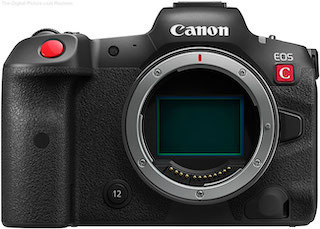Canon has introduced the EOS R5 C Full-Frame Mirrorless Camera, a hybrid, RF-mount camera that is the company’s first 8K model. The new camera showcases video formats and features from the company’s award-winning Cinema EOS line, alongside select still capabilities. In other news, Canon also announced a firmware update for its EOS C70 4K Digital Cinema Camera that implements sought after features such as Cinema Raw Light internal recording as well as frame and interval recording modes.
 “Imaging professionals are living in a multimedia world. Gone are the days of only needing to be sufficiently equipped and skilled at video or stills,” said Tatsuro “Tony” Kano, executive vice president and general manager of Canon U.S.A.’s imaging technologies & communications group. “The EOS R5 C squarely takes aim at providing end-users with a solution that can tackle all facets of the ever-demanding multimedia and content production landscape. Canon is confident this all-in-one solution can help improve the workflow for a variety of content creators.”
“Imaging professionals are living in a multimedia world. Gone are the days of only needing to be sufficiently equipped and skilled at video or stills,” said Tatsuro “Tony” Kano, executive vice president and general manager of Canon U.S.A.’s imaging technologies & communications group. “The EOS R5 C squarely takes aim at providing end-users with a solution that can tackle all facets of the ever-demanding multimedia and content production landscape. Canon is confident this all-in-one solution can help improve the workflow for a variety of content creators.”
The EOS R5 C camera can record non-stop, uninterrupted 8K/60P thanks to an active cooling system. 8K video delivers outstanding definition and realism with four times the resolution of 4K video, enabling unprecedented capabilities in video expression and highly flexible workflows, such as 4K cropping from 8K footage.
The EOS R5 C camera can record high frame rate video up to 120P at 4K resolution in 4:2:2 10-bit without cropping the sensor, an ideal option when shooting scenes full of fast-paced action or when the camera is paired with a gimbal or drone. Canon’s renowned Dual Pixel CMOS AF is functional even in HFR shooting. Unlike some cameras where audio is not recorded during HFR shooting, the EOS R5 C camera can record .WAV audio as a separate file from video, virtually eliminating the need for separate audio recording.
 The EOS R5 C is the first Canon camera to provide internal 8K (8192x4320) 60P Cinema Raw Light recording. Cinema Raw Light is a popular and valuable format found in other Canon Cinema EOS cameras such as the EOS C300 Mark III and EOS C500 Mark II. This feature captures the full dynamic range of the sensor and provides video data with a cinematic look, optimized for advanced grading and HDR, in a more manageable file size than Cinema RAW. Cinema Raw Light now has three newly developed modes, Raw HQ (high quality), Raw ST (standard quality), and Raw LT (light recording). All three modes are 12-bit regardless of frame rate. The EOS R5 C can also record 8K video in MP4 format, ideal for quicker delivery.
The EOS R5 C is the first Canon camera to provide internal 8K (8192x4320) 60P Cinema Raw Light recording. Cinema Raw Light is a popular and valuable format found in other Canon Cinema EOS cameras such as the EOS C300 Mark III and EOS C500 Mark II. This feature captures the full dynamic range of the sensor and provides video data with a cinematic look, optimized for advanced grading and HDR, in a more manageable file size than Cinema RAW. Cinema Raw Light now has three newly developed modes, Raw HQ (high quality), Raw ST (standard quality), and Raw LT (light recording). All three modes are 12-bit regardless of frame rate. The EOS R5 C can also record 8K video in MP4 format, ideal for quicker delivery.
The EOS R5 C supports RAW output via HDMI for ProRes RAW recording with compatible a external recorder. When connecting the EOS R5 C with a supported external recorder, users can shoot in Apple ProRes Raw at up to 8K/30P. Proxy data can also be simultaneously recorded to an SD card in-camera, helping to provide efficient post-production operations.
The EOS C70 can now capture 12-bit Cinema Raw Light internally to compatible SD cards. Cinema Raw Light captures the widest dynamic range from the Dual Gain Output sensor (16+ stops total) and allows the most flexibility to grade captured content. Three quality settings of Cinema Raw Light will make their way into the EOS C70 via the firmware update. The settings are: Raw HQ (high quality), Raw ST (standard quality), and RAW LT (light recording). All three modes are 12-bit regardless of frame rate. Lastly, Cinema RAW Light is compatible with proxy and double-slot recording.
The addition of frame and interval recording modes is a direct result of user feedback and adds even more recording flexibility to the EOS C70 camera by allowing easy creation of stop motion and time-lapse sequences when recording in the XF-AVC and MP4 formats. Frame recording is for stop motion capture, and every press of the record button captures a user-determined number of frames. Interval recording sets the interval and number of frames to be captured for time-lapse sequences. Both recording modes help operators further tell their story in a more creative and inspiring form and are easy to use.
Both the EOS R5 C and the EOS C70 will be available in March. Canon did not release any pricing information.
For more details about both cameras visit the Canon website at usa.canon.com.
